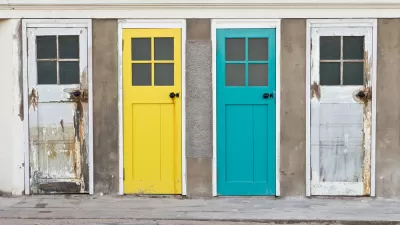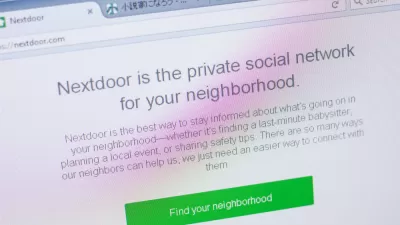A decade into its history, the hyperlocal social media site Nextdoor is looking for feedback and hoping to expand its reach before the 2018 and 2020 elections.

Carla Marinucci reports on the recent efforts of the San Francisco-based social media company Nextdoor, which is looking to expand its influence in the political arena after a decade of rapid growth and no lack of controversy along the way.
With regard to the company's rapid growth, Marinucci reports these statistics:
Since its founding a decade ago, Nextdoor has achieved penetration in over 70 percent of American neighborhoods — with eye-popping success in some of the country’s biggest cities, including San Francisco, where it’s active in 97 percent of all city neighborhoods, Chicago (85 percent), and Washington DC (81 percent). It recently launched in the United Kingdom, where it has already achieved 60 percent penetration in the country’s neighborhoods, the company says.
As planners and community activists in many of those areas know very well, "Nextdoor neighbor-to-neighbor discussions may — for good or bad — represent a new power to sway public opinion on issues and initiative, a challenge to traditional political campaigns."
Some of those discussions have attracted controversy. The company had to make changes to the platform after an article by Pendarvis Harshaw revealed problems with racial profiling on the site. A little over a year later, the site was reporting a 75 percent reduction in racist posts on the site.
For examples of the already realized positive potential of the site, Marinucci refers to several episodes experienced in the city of San Jose, including mobilization during a flooding event earlier this year, as well as mobilization of volunteers for the Beautify San Jose initiative.
FULL STORY: Nextdoor eyes 2018, aims for neighbor-to-neighbor approach in politics

Study: Maui’s Plan to Convert Vacation Rentals to Long-Term Housing Could Cause Nearly $1 Billion Economic Loss
The plan would reduce visitor accommodation by 25,% resulting in 1,900 jobs lost.

Placekeeping: Setting a New Precedent for City Planners
How a preservation-based approach to redevelopment and urban design can prevent displacement and honor legacy communities.

Using Old Oil and Gas Wells for Green Energy Storage
Penn State researchers have found that repurposing abandoned oil and gas wells for geothermal-assisted compressed-air energy storage can boost efficiency, reduce environmental risks, and support clean energy and job transitions.

Washington State Plans Ambitious ‘Cycle Highway’ Network
The state is directing funding to close gaps in its existing bike network and make long-distance trips more accessible.

Homeowners Blame PG&E for Delays in ADU Permits
The utility says it has dramatically reduced its backlog, but applicants say they still face months-long delays for approvals for new electrical work.

Rethinking Wildfire Defense: How a Landscape Approach Can Protect Neighborhoods
Post-fire analysis of the Eaton Fire reveals that a landscape approach — including fire-resistant vegetation, home hardening, and strategic planning — can help reduce wildfire risk, challenging assumptions that trees and plants are primary fire hazards.
Urban Design for Planners 1: Software Tools
This six-course series explores essential urban design concepts using open source software and equips planners with the tools they need to participate fully in the urban design process.
Planning for Universal Design
Learn the tools for implementing Universal Design in planning regulations.
Borough of Carlisle
Caltrans
Heyer Gruel & Associates PA
Institute for Housing and Urban Development Studies (IHS)
City of Grandview
Harvard GSD Executive Education
Salt Lake City
NYU Wagner Graduate School of Public Service
City of Cambridge, Maryland





























